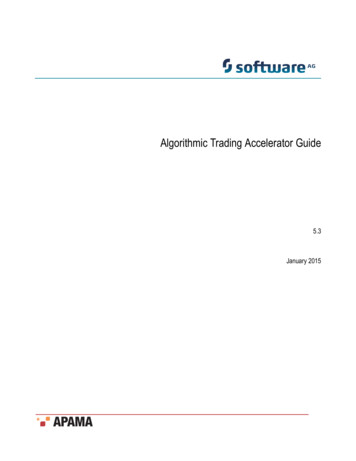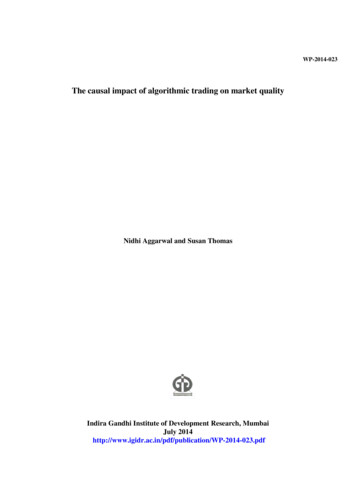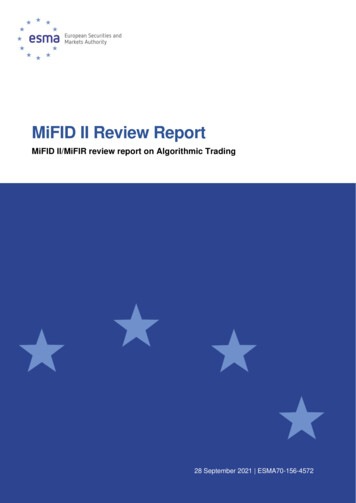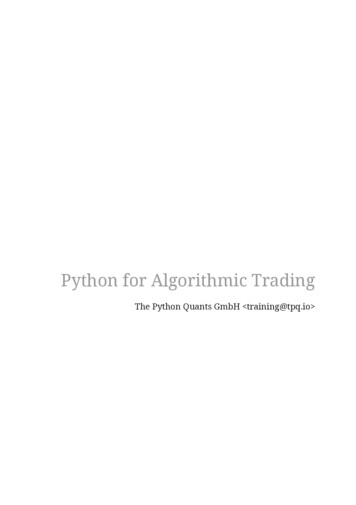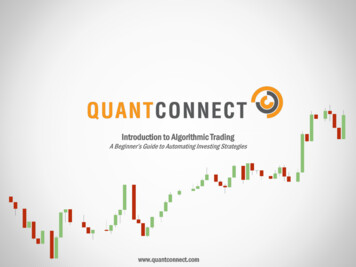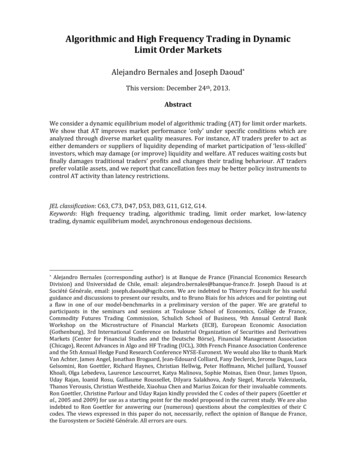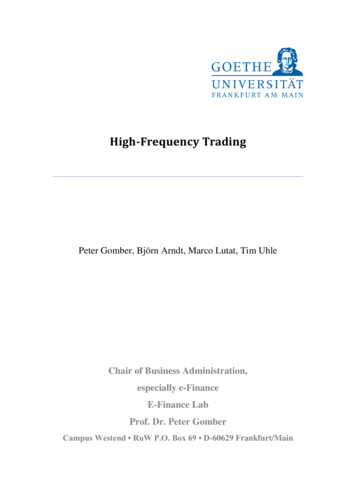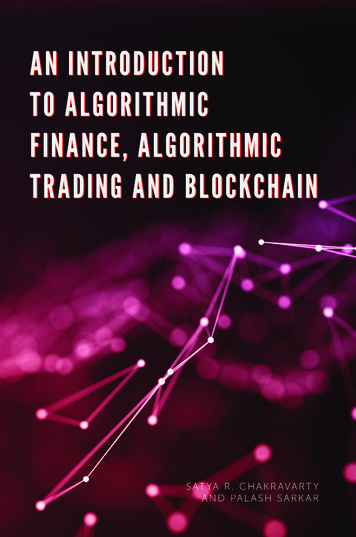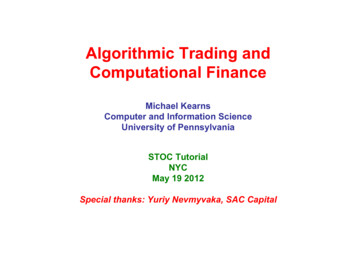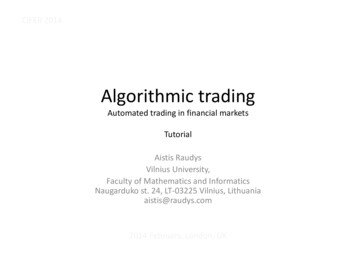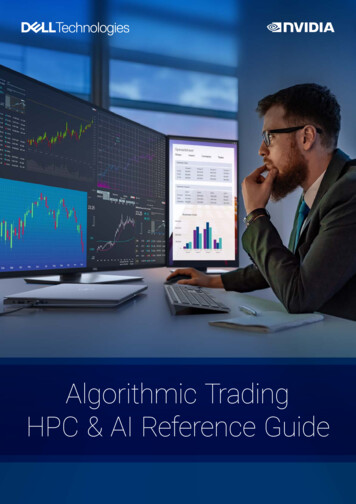
Transcription
Algorithmic TradingHPC & AI Reference Guide
AuthorsErik VynckierErik Vynckier is board member of Foresters Friendly Society and chair of the Instituteand Faculty of Actuaries (Research and Thought Leadership Board), following a career ininvestment banking, insurance, asset management and the petrochemical industry.He co-founded EU initiatives on high performance computing and big data in finance andco-authored “High-Performance Computing in Finance” and “Tercentenary Essayson the Philosophy and Science of Leibniz”. Erik graduated as MBA at London BusinessSchool and as chemical engineer at Universiteit Gent.Gabriel Pirastru – Dell Technologies, HPC & AI TeamJohn Ashely – NVIDIA FSI teamKeith Manthey and Darren Miller – Dell Technologies, UDSFor any enquires regarding Algorithmic Trading and Dell Technologies:Gabriel Pirastru@Dell.comFor any enquires regarding Algorithmic Trading and NVIDIA:jashley@nvidia.comFor any enquiries regarding Algorithmic Trading and storage solutions:Keith.Manthey@dell.comContact your local HPC contact: HPC NA Sales Team@Dell.comEMEA HPC Team@Dell.comAPJ HPC Team@Dell.comHPC Latam@Dell.comDell Technologies Useful Links: Guides to Connected FinanceHigh-Performance ComputingHPC and AI Innovation LabReference Architectures
ContentsIntroduction.6Level Setting.6i. Why do we do algorithmic trading?.6ii. Pattern detection and Risk.6iii. Back-testing.6iv. Short-shelf time.7v. Who is doing algorithmic trading?.7vi. What is the workflow of algorithmic trading?.7vii. How big is algorithmic trading versus ‘standard’ trading?.8I. Industry.91. Information technology as a competitive advantage in financial services.92. Electronic trading, algorithmic trading and high frequency trading. 10i. Electronic trading. 10ii. Algorithmic trading. 10iii. High frequency trading. 10iv. Algorithmic trading market.11v. Products traded in algorithmic trading.11vi. Characteristics of trading.12vii. Characteristics of algorithmic tradings.123. Strategy development process in algorithmic computing.13i. Passive management. 14ii. Systematic risk. 14iii. Active management.15iv. ETFs.15v. Arbitrage Trading.15vi. Factors to consider.154. Markets and market structure. 16i. Exchanges. 16ii. Where futures trade. 17iii. Where Forex trade - Foreign Exchange Market. 17iv. Where corporate bonds trade. 17v. Where OTCs – over the counter - trade. 18vi. Repos - repurchase agreements.19vii. Clearing.19viii. Market rules - regulators.195. Regulations in the capital markets. 206. Financial computation. 21i. Monte Carlo simulation. 21ii. Mathematical optimisation. 22iii. Portfolio optimisation. 22iv. Back-testing. 23v. Trading. 23vi. Short Shelf Life. 247. Trends - where’s the industry heading?. 24i. Artificial intelligence. 24ii. Cryptocurrency. 25iii. Quantum computing. 25
II. Technical. 251. Importance of technology for success. 252. Algorithm development. 25Time-series analysis. 25Linear and non-linear regressions. 25Machine learning and deep neural networks. 263. Technology review software. 26i. Programming languages. 26ii. Parallel programming languages. 26iii. How to choose the right programming language. 264. Databases. 275. Compute. 27i. GPUs. 27i. FPGAs programming. 28ii. Virtualisation/ cloud. 28iii. VDI Virtual desktop infrastructure. 286. Networking. 297. Factors to take into consideration. 29i. Speed versus flexibility. 29ii. High availability. 298. Algorithmic trading environment. 29III. How to size the best solution?. 301. Overview of the algorithm trading infrastructure. 30i. Challenges identification. 30ii. The algorithmic trading process. 30iii. Two environments: algorithmic development and (high-frequency) trading. 302. Data-Sources, types and movement. 31i. Exchange data. 31ii. External data. 31iii. Internal data. 323. Storage and databases. 32i. Time Series - tick databases. 32ii. RDBMS. 34iii. NoSQL. 34iv. Data-lake. 354. Compute cluster. 37i. Overview. 37ii. Where to run which application. 38iii. Hardware infrastructure. 38iv. Hypervisor. 40v. Containers. 425. Networking. 436. Users. 447. Cloud computing. 458. Software. 45IV. Decision process. 471. Creating a solution. 47i. Consulting. 47ii. Testing. 48iii. Financing. 48iv. Deployment, support, management. 48
v. Community. 482. Why Dell Technologies advantage. 49i. Supercomputers at customers’ disposal. 49ii. Software optimisation. 49iii. Green and social responsibility. 49V. Appendix. 501. Industry terminologies. 502. External Links. 503. Some literature. 51
IntroductionInformation technology has been a driver of innovation in the financial industry over at least the past thirty years.What is the status quo today, with more data and computing power at our disposal than ever before?This paper will highlight algorithmic trading as one example of doing more with information technology in finance.Algorithmic trading is automatic electronic trading using computer programs to make buy and sell decisions withoutimmediate human intervention. The human touch is in the intelligence the program embeds. However, the step toartificial intelligence is now being made.Algorithmic trading describes the overall industry of both algorithm development and high-frequency trading.Algorithmic development refers to the design of the algorithm, mostly done by humans. High-frequency trading, onthe other hand, involves putting the developed algorithm in practical use for trading. This latter is a very low-latencyand high-volume strategy and is being done by a machine.We’ll look at how the industry operates, before moving to the technical challenges and how these are beingaddressed. Finally, we’ll explore how to size the best solution combining high performance computation and datastorage to serve your needs best.Level Settingi. Why do we do algorithmic trading?The ability to remove humans from trading has several advantages such as automation, speed, accuracy andreduced costs, data retrieval and trading speed but most importantly not letting human emotions impact trade. Accuracy; algorithms are made of complex correlations of data and events/ pattern detection that enable them toreact to information (news, market price changes, events ) and place trade accordingly to make profit. Aggregate large volume of data; by leveraging compute and storage technology, algorithms can now crunchlots of data quickly. Additionally, they can be tested on historical data back from 10, 20 or more years for betteraccuracy. Data Retrieval Speed; updating the algorithm in reaction to new data (market data, events, strategy change )is critical. Therefore, having enough compute power, the right database and networking technology to makenecessary changes is key. Emotions; removing emotions and placing trade at the right time ultimately results in profitability improvement. Trading speed; High-Frequency Trading (HFT) uses latency to leverage market information to make profitsbefore competition. Speed is in milliseconds; in HFT latency is often the only determinant for profit/ loss. Not allalgorithmic trading is high-frequency, traders will still optimise their trading platform to execute trade with lowlatency. This is to avoid large price changes between the moment the computer places the trade and the exchangereceives it.ii. Pattern detection and RiskOne of the primary purposes of using algorithms is to detect patterns amongst data against a trading strategy.Basically, each data input, e.g. market movements (up/down), important news, impacts the market. Having thisunderstanding enables the trader to decide which action to take as a result.Secondly, the risk associated is important to take into consideration. Does the trader want to take a high-reward/high-risk strategy or a safe-strategy, resulting in low but steady returns? To assess the risk level, Monte Carlo andother risk analyses are being performed.The combination of data-correlation, pattern detection, risk analysis and portfolio optimisation will form the algorithm.iii. Back-testingAnother advantage to algorithmic trading is the ability to do back-testing. Previously, traders had no idea whethertheir strategy would work before trying. Now, algorithms first run on past data to see whether they yield satisfyingresults. Once they reach the right level of profit-making, they are then applied to the real world.Additionally, using emerging methods such as VAEs (Variational Autoencoders) and GANs (Generative AdversarialNetworks), algorithms can be applied in simulated market environments. VAEs and GANs are generative models andare a great way to learn any kind of distribution using unsupervised learning.6
iv. Short-shelf timeWhen algorithms are being deployed and start trading, the market and competition will inevitably react. Competitorsplay an endless game to stay ahead and make profits, in this play there are only winners or losers. Whether profitsare made is often dictated by the ability to deploy large and powerful IT infrastructures that will enable the firm tocorrelate large amount of data and use it to trade at the lowest latency possible.As more and more algorithmic trading strategies are being used, it can be more difficult to deploy them profitably.Indeed, competition is so stiff that entry barriers are high, especially regarding the cost of a performing ITinfrastructure.v. Who is doing algorithmic trading?Many algorithmic trading firms are market makers. This is a firm that stands ready to buy and sell a stock on aregular and continuous basis at a publicly quoted price. Customers use them to place large trades.Large quantitative funds (also called investment or hedge funds) and banks have an algorithmic trading departmentand benefit from having large funds to invest along with the ability to correlate their own internal data with thealgorithm.High-frequency trading firms are leveraging low-latency technologies to make profits. They often place trades onbehalf of other financial institutions.vi. What is the workflow of algorithmic trading?First, the algorithm has to be developed. This is being done by a mix of data science, statistics, risk analysis andDevOps. Secondly, the algorithm will be used for back-testing, trying it against past data. This gets repeated untilthe algorithm is refined (i.e. produces the expected profits). Once results are satisfactory, the algorithm is put inproduction and trades on behalf of the firm. The yields produced by the algorithm trading in the real-world marketswill produce data and further feed the algorithm in the backend.This process puts a lot of stress on the infrastructure, since continuous data must be fed to the algorithm, so that itproduces best results.Additionally, the high-frequency trading platform places thousands of trades within a very short amount of time,before anyone, or the market, can react. Therefore, it must have the lowest latency possible.Each sub-part will be further explored in the paper.Algorithm Development (AD)‘High Frequency’TradingADWhat productdo you wantto you trade?What is yourstrategy?On whichexechange doyou want totrade?Work on thealgorithmBack-TestPut inproductionRefine thealgorithm1234567Algorithm and strategy optimisation1. ProductsTermEquitiesCurrencies (FX)DefinitionShares of a company (also called stock)Dollar, Euro, Pound FuturesBetting on the future value of an assetBondsGovernments or companies’ debtDerivativesBetting on artificial values(e.g. whether the whole NASDAQ’s value will increase/decrease)2. Strategy: the trader will calibrate the algorithm according to a strategy i.e. risk level, long vs. short term.3. Exchanges: places where products are being bought and sold, exchanges are split by product and geography(e.g. Deutsche Börse is an exchange for equities and securities in Germany) – see part viii, Market rules.4. Work on the algorithm: run risk analysis, time-series, artificial intelligence techniques and create your ownalgorithm. The algorithm will be based on the product chosen (how liquid it is), the market it trades (data available)7
and strategy (level of risk willing to take). Then analysis will be done to find which patterns in the market influencehave most effects on these factors.5. Back-test, will then take this algorithm and test it on historical and simulated data.6. Production: trade with the algorithm. In the past high-frequency trading was the norm, i.e. executing many trades(thousands or millions) in a fraction of second before the competition can react. The problem is that there is onlyspace for so many traders operating such a strategy. Therefore, the new key competitive advantage is how muchdata and how well one can compute and leverage.7. Refine the algorithm: see how the market reacts and change your algorithm to get even better profits.As a result, we can think of algorithmic trading as a never-ending loop between refining the algorithm and tradingwith it.Algorithmic Trading LoopAlgorithm Development(High-Frequency) Tradingvii. How big is algorithmic trading versus ‘standard’ trading?The below graph indicates the share in percentage of algorithmic trading against traditional trading amongstfinancial products.Market Share of Algorithmic Trading by Asset ed Income10%0%2004200620082010201220142016As of 2017Source: Goldman Sachs, Aite Group8
I. Industry1. Information technology as a competitive advantage in financial servicesThe financial industry is a heavy user of information technology in all its forms: from the basic administration andaccounting software for managing its clients and its own assets and loans to the online availability of accounts,transactions and cyber security.In the investments business, information technology is used for front office,
As more and more algorithmic trading strategies are being used, it can be more difficult to deploy them profitably. Indeed, competition is so stiff that entry barriers are high, especially regarding the cost of a performing IT infrastructure. v. Who is doing algorithmic trading? Many
